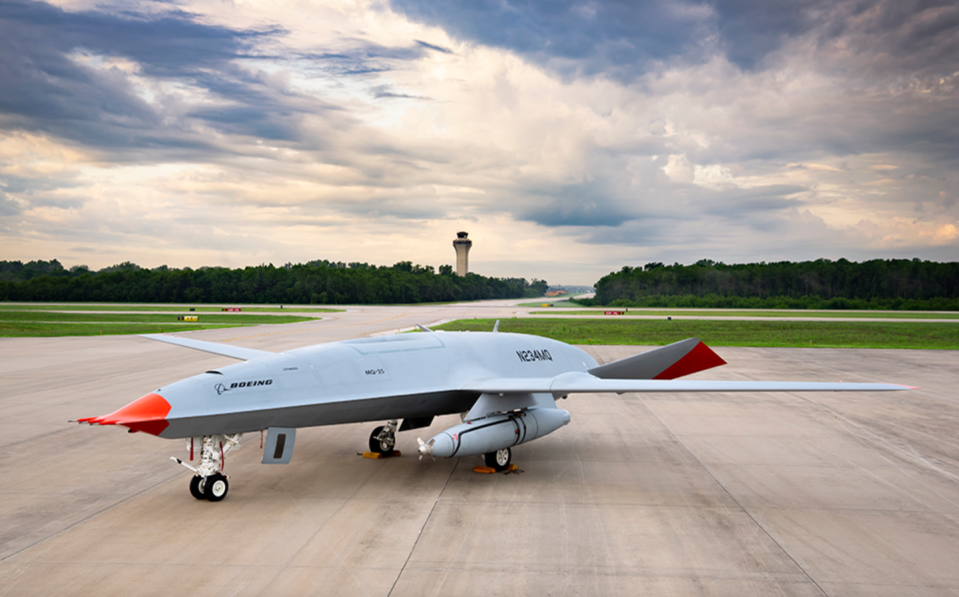The Navy’s New Refueling Drone Just Provided Gas to a F-35
The U.S. Navy’s MQ-25A Stingray refueling tanker successfully refueled a F-35C strike fighter.
The MQ-25A will extend the range of nearly all aircraft based on aircraft carriers.
The drone was also described as a “qualitative leap” by a group of Chinese military officers.
The Navy’s new aerial refueling drone transferred fuel to a F-35C Joint Strike Fighter for the first time. The successful test is the latest step in giving carrier-based fighters longer legs than ever before, allowing them to fly and fight while keeping the aircraft carrier safely out of range of enemy weapons.
The MQ-25A concept was also fawned over by Chinese military officers in an analysis of the system, indicating Beijing’s navy could end up with a refueling tanker of its own.
The test took place place on Monday, September 13, near the MidAmerica St. Louis Airport in Mascoutah, Illinois. An operational MQ-25 prototype, named T-1, met up with a Navy F-35C from Air Test Wing and Evaluation Squadron Two Three (VX-23).
The F-35C, according to the Navy’s Air Systems Command, “approached T1, performed formation evaluations, wake surveys, drogue tracking and plugged with the MQ-25 test asset at 225 knots calibrated airspeed (KCAS) and altitude of 10,000 feet. From the ground control station, an air vehicle operator then initiated the fuel transfer from T1’s aerial refueling store to the F-35C.”
➡ You love badass military planes. So do we. Let’s nerd out over it together.
The U.S. Navy first flew a fixed-wing drone from an aircraft carrier in 2013. The tests, involving the Northrop Grumman X-47B and the aircraft carrier USS Bush, validated the carrier-based drone concept. The Navy then took several years to debate how to deploy a drone across the carrier fleet.

One school of thought held that the service should deploy stealthy, long-range strike drones to make up for the relatively short ranges of the F/A-18E/F Super Hornet and F-35C Joint Strike Fighter. Each carrier might embark up to a dozen drones with a range of 1,000 miles or more, allowing carriers to strike targets but remain safely out of range of most anti-ship weapons.
Another, more controversial school of thought was the Navy should instead deploy unarmed drone tankers. Rather than field one squadron of drones that could do one mission—long-range strike—drone tankers could bless any carrier-based airplane, from F/A-18E/F strike fighters to E-2D Advanced Hawkeye earlier warning aircraft--with extended range and greater flight time. This is particularly useful for the carrier-based F-35C, which has a combat radius of 670 nautical miles but which cannot equip wing-mounted external fuel tanks without compromising its stealthy design.
The U.S. Navy plans to buy 76 MQ-25A Stingray drones for a total of $1.3 billion, and the drone is scheduled to reach initial operating capability by 2025. The Navy is also considering other missions for the drone, missions that could include intelligence, surveillance, and reconnaissance, and even strike missions.
A group of PLA officers reviewed the MQ-25A Stingray and concluded how unmanned aerial refueling will render a qualitative leap for the U.S. Navy's future war-fighting capability. This latest study may signal an intent to emulate for PLA Navy carrier-borne aviation development. pic.twitter.com/fHBaj3ZJJ2
— Collin Koh (@CollinSLKoh) September 7, 2021
Meanwhile, a group of People’s Liberation Army officers recently studied the MQ-25A and concluded it would give the U.S. Navy a “qualitative leap”. The Chinese military officers believe the drones will enhance the survivability of American carriers, making them more “resilient”. The thread above suggests such a glowing endorsement could indicate that China will eventually build its own MQ-25A to support its own growing fleet of aircraft carriers.
🎥 Now watch this:
You Might Also Like

